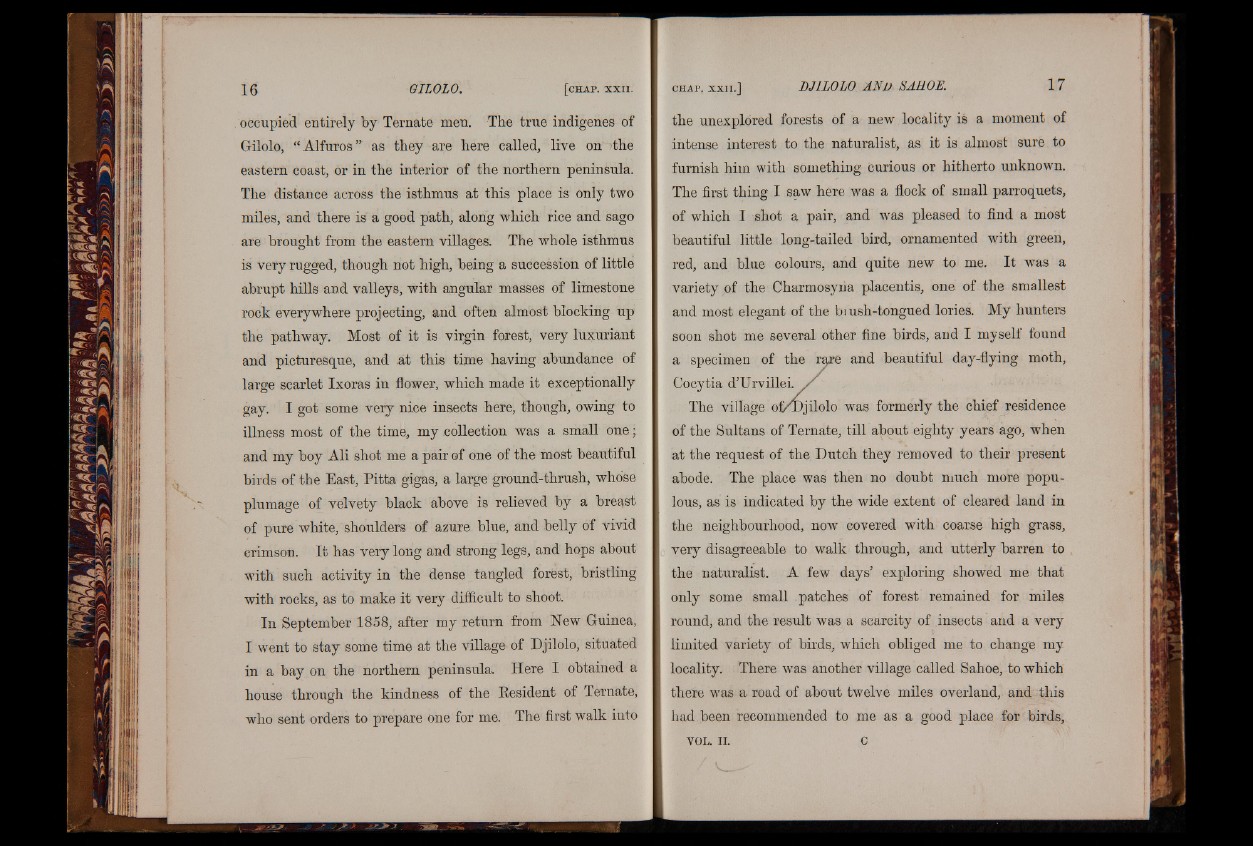
occupied entirely by Ternate men. The true indigenes of
Gilolo, “Alfuros” as they are here called, live on the
eastern coast, or in the interior of the northern peninsula.
The distance across the isthmus at this place is only two
miles, and there is a good path, along which rice and sago
are brought from the eastern villages. The whole isthmus
is very rugged, though not high, being a succession of little
abrupt hills and valleys, with angular masses of limestone
rock everywhere projecting, and often almost blocking up
the pathway. Most of it is virgin forest, very luxuriant
and picturesque, and at this time having abundance of
large scarlet Ixoras in flower, which made it exceptionally
gay. I got some very nice insects here, though, owing to
illness most of the time, my collection was a small one;
and my boy Ali shot me a pair of one of the most beautiful
birds of the East, Pitta gigas, a large ground-thrush, whose
plumage of velvety black above is relieved by a breast
of pure white, shoulders of azure blue, and belly of vivid
crimson. It has very long and strong legs, and hops about
with such activity in the dense tangled forest, bristling
with rocks, as to make it very difficult to shoot.
In September 1858, after my return from Hew Guinea,
I went to stay some time at the village of Djilolo, situated
in a bay on the northern peninsula. Here I obtained a
house through the kindness of the Resident of Ternate,
who sent orders to prepare one for me. The first walk into
the unexplored forests of a new locality is a moment of
intense interest to the naturalist, as it is almost sure to
furnish him with something curious or hitherto unknown.
The first thing I saw here was a flock of small parroquets,
of which I shot a pair, and was pleased to find a most
beautiful little long-tailed bird, ornamented with green,
red, and blue colours, and quite new to me. It was a
variety of the Charmosyiia p-lacentis, one of the smallest
and most elegant of the biush-tongued lories. My hunters
soon shot me several other fine birds, and I myself found
a specimen of the rare and beautiful day-flying moth,
Cocytia d’Urvillei. /
The village of/13jilolo was formerly the chief residence
of the Sultans of Ternate, till about eighty years ago, when
at the request of the Hutch they removed to their present
abode. The place was then no doubt much more populous,
as is indicated by the wide extent of cleared land in
the neighbourhood, now covered with coarse high grass,
very disagreeable to walk through, and utterly barren to
the naturalist. A few days’ exploring showed me that
only some small patches of forest remained for miles
round, and the result was a scarcity of insects and a very
limited variety of birds, which obliged me to change my
locality. There was another village called Sahoe, to which
there was a road of about twelve miles overland, and this
had been recommended to me as a good place for birds,
VOL. II. c